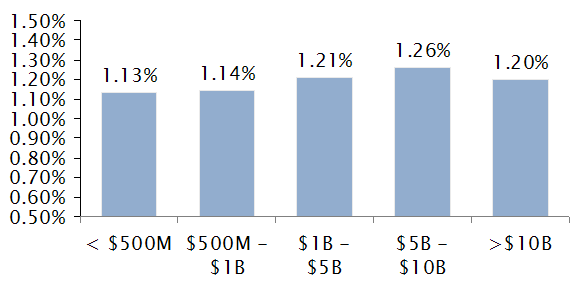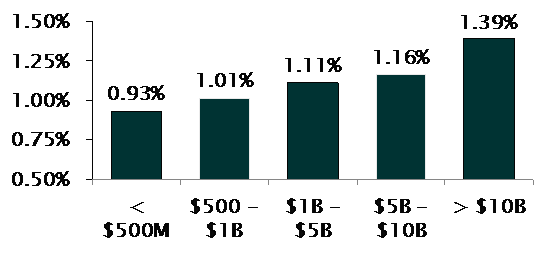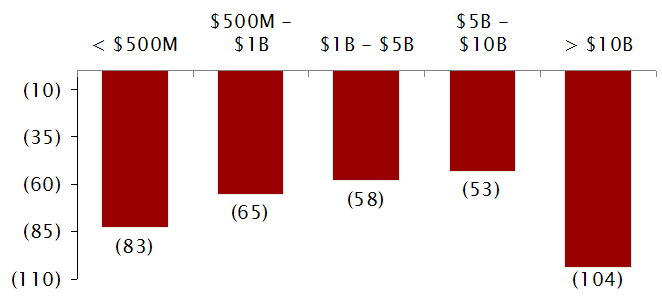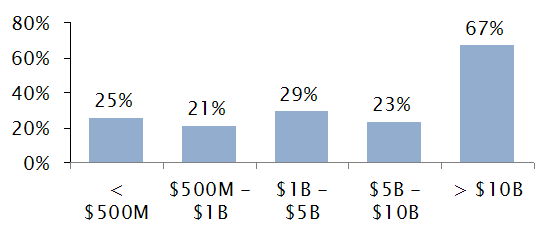|
THE CHANGING LANDSCAPE OF BANKING
THE CHANGING LANDSCAPE OF BANKING
In the past years, mid-size banks enjoyed two advantages over the rest of the industry: they were the most profitable and they traded at the best multiples. Certainly there were exceptions, but, as a rule, SuperCommunity Banks had the best currency for acquisitions and showed the best performance of all size segments (relative to under $1 billion or over $100 billion).
The picture has changed dramatically over the past 18 months. Consider the two graphs below. The first graph depicts industry profitability by asset size in 1996. It shows near-parity across bank size ranges, with mid-size banks performing best.
Profitability, 1996

The second graph shows the same size distribution ten years later, and is starkly different: mega-banks out-perform all other size categories by a significant margin. This is a sobering picture for all non-mega banks.
Profitability, 2006

The question must be asked: how did the large banks achieve such superior performance while facing the same challenges we all do, ranging from margin compression to a shrinking deposit base?
The next graph shows that margin isn't the answer. Mega-banks lost more margin income than any other size group over the past ten years. In fact, they suffered greater margin loss than even the smallest bank group. Their success is even more startling when one considers this fact.
Margin Change

The big banks are winning due to four core competencies that have served them well during these difficult times:
Revenue diversification.
It is true that larger banks have more revenue diversification opportunities than their smaller brethren, but I attribute their success to a deliberate move toward lesser reliance on net interest margin rather than scale. I remember vividly when Dick Kovacevich drove the non-interest-income of Norwest with determination and tenacity year after year by goaling the percent of NII to total income and methodically raising it. I am sure that other mega-bank CEOs had the same goal in mind. The result has been impressive, with most mega-banks generating at least 40% of their income from sources outside the margin, and many are north of 50%. This metamorphosis of the income statement helped large banks immunize themselves to a degree from margin fluctuations to which so many small banks are vulnerable.
Disciplined cost containment.
When I saw the startling graph below I realized how deep the chasm between the large and smaller banks is when it comes to cost containment.
Efficiency Improvement, 1996-2006

For many SuperCommunity Banks cost reduction is an event, a project with a beginning and an end, and with cost creep starting almost immediately after the project is over. For larger banks, it's a way of life. It's easier when the "heart" dimension of your management team is lower and when discipline rules. It is also necessary to have BOTH "heart" and discipline. Too many community banks are too benevolent. Having the intestinal fortitude to adopt cost containment as a discipline vs. an event, and to stick with it even when it impacts favored employees, is a necessary ingredient that Community banks need to possess in order to compete with the big banks. Disciplined growth.
Growth is a good thing, but not when it is unprofitable growth. Mega-banks have established for years a "look-back" process to ensure that profitability projections associated with growth, whether it's organic (such as de novo branching) or by acquisition, stay true to the initial projections. All too often we see acquisitions that do not deliver the financial results projected, yet nothing is done about it. Similarly, break-even expectations from de novo branching, line of business establishment and even "lift-outs" of groups of banking professionals are often aggressive at the onset and then watered down over time. Large banks have become more careful with their profitable growth expectations in recent years, after a decade of botched acquisitions that never met projections, and the results are reflected in their financial performance. Capital allocation.
Large banks have developed systematic approaches to capital allocation where the dollars will create the greatest shareholder value. There are a few SuperCommunity banks, such as Webster, that have approached capital allocations in a similar fashion, yet capital is among our scarcest resources. Allocating the capital to those businesses that offer the best returns often serves the shareholders not only in the short-run but also long-term, through franchise value enhancements.
This article is not intended to be an ode to big banks. Rather, it is designed to demonstrate how management disciplines can be used to improve financial performance regardless to size. SuperCommunity banks need to understand how the big banks achieved their superior performance, and adopt some of those disciplines without losing their core identity. If they are successful, they will indeed achieve the "best of both worlds" ideal that we all strive for: outlocal the nationals and outnational the locals.
|


